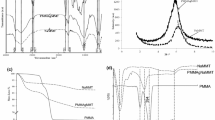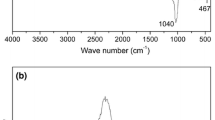Abstract
A flexible composite adsorbent combination of polypyrrole and montmorillonite clay (PPy-MMT) has been prepared by in situ oxidative polymerization method. This well-achieved adsorbent has amphoteric characteristics and has been explored in many adsorption processes related to heavy metals removal, more especially Cr(VI) from the water phase. However, the progressive accumulation of Cr(VI) onto the adsorbent surface reduces its adsorption capacity before adsorbent depletion. This factor limits the application of the adsorbent due to high cost and environmental impact related to adsorbent disposal after use. Here, we report the feasibility of different regenerating agents to recover adsorbed Cr(VI) and activate the tunable surface charge of the adsorbent composite to restore its initial adsorption capacity until exhaustion. The recycled PPy-MMT adsorbents were characterized by FTIR, TGA and EDS analysis. At low solution pH, PPy-MMT is protonated resulting in high adsorption capacity for Cr(VI) through electrostatic attraction and ion exchange while simultaneously reducing Cr(VI) to less toxic Cr(III). The spent adsorbents were reversibly subjected to sequential adsorption–desorption cycles between adsorbent neutral state and the oxidized state using different concentrations of regenerating agents including NaOH, NH4OH, HCl, NH4Cl and HNO3, respectively. The results suggested that with 0.01 M NaOH and 0.5 M HCl, PPy-MMT could be used for over five cycles for Cr(VI) removal with more than 80% regeneration efficiency indicating potential applicability as a re-usable adsorbent for Cr(VI) removal.










Similar content being viewed by others
References
Bhatnagar A, Minocha AK (2006) Conventional and non-conventional adsorbents for removal of pollutants from water—a review. Indian J Chem Technol 13:203–217
Rivera-Utrilla J, Sanchez-Polo M, Gomez-Serrano V, Alvarez PM, Alvim-Ferraz MCM, Dias JM (2011) Activated carbon modifications to enhance its water treatment applications: an overview. J Hazard Mater 187:1–23
Chen D, Wang L, Ma Y, Yang W (2016) Super-adsorbent material based on functional polymer particles with a multilevel porous structure. NPG Asia Mater 8:e301–e308
Akharame MO, Fatoki OS, Opeolu BO (2019) Regeneration and reuse of polymeric nanocomposites in wastewater remediation: the future of economic water management. Polym Bull 76:647–681
Zanella O, Tessaro IC, Feris LA (2014) Desorption- and decomposition-based techniques for the regeneration of activated carbon. Chem Eng Technol 37:1447–1459
Berenguer R, Marco-Lozar JP, Quijada C, Cazorla-Amoros D, Morallon E (2010) Electrochemical regeneration and porosity recovery of phenol-saturated granular activated carbon in an alkaline medium. Carbon 48:2734–2745
Owlad M, Aroua MK, Daud WMA (2010) Hexavalent chromium adsorption on impregnated palm shell activated carbon with polyethyleneimine. Bioresour Technol 101:5098–5103
Wang J, Pan K, He Q, Cao B (2013) Polyacrylonitrile/polypyrrole core/shell nanofiber mat for the removal of hexavalent chromium from aqueous solution. J Hazard Mater 244–245:121–129
Setshedi KZ, Bhaumik M, Songwane S, Onyango MS, Maity A (2013) Exfoliated polypyrrole-organically modified montmorillonite clay nanocomposite as a potential adsorbent for Cr(VI) removal. Chem Eng J 222:86–197
Jafari MT, Saraji M, Sherafatmand H (2014) Polypyrrole/montmorillonite nanocomposite as a new solid phase microextraction fiber combined with gas chromatography-corona discharge ion mobility spectrometry for the simultaneous determination of diazinon and fenthion organophosphorus pesticides. Anal Chim Acta 814:69–78
Ruotolo LAM, Gubulin JC (2005) Chromium(VI) reduction using conducting polymer films. React Funct Polym 62:141–151
Vakili M, Deng S, Cagnetta G, Wang W, Meng P, Liu D, Yu G (2019) Regeneration of chitosan-based adsorbents used in heavy metal adsorption: a review. Sep Purif Technol 224:373–387
Momina SM, Isamil S (2018) Regeneration performance of clay-based adsorbents for the removal of industrial dyes: a review. RSC Adv 8:24571–24587
Zhang X, Bai R (2003) Surface electric properties of polypyrrole in aqueous solutions. Langmuir 19:10703–10709
Chen Y, Xu H, Wang S, Kang L (2014) Removal of Cr(VI) from water using polypyrrole/attapulgite core–shell nanocomposites: equilibrium, thermodynamics and kinetics. RSC Adv 4:17805–17811
Bhaumik M, MaityA SVV, Onyango MS (2011) Enhanced removal of Cr(VI) from aqueous solution using polypyrrole/Fe3O4 magnetic nanocomposite. J Hazard Mater 190:381–390
Ballav N, Maity A, Mishra SB (2012) High efficient removal of chromium(VI) using glycine doped polypyrrole adsorbent from aqueous solution. Chem Eng 198–199:536–546
Neoh KG, Lau KKS, Wong VVT, Kang ET, Tan KL (1996) Structure and degradation behavior of polypyrrole doped with sulfonate anions of different sizes subjected to undoping—redoping cycles. Chem Mater 8:167–172
Bagreev A, Rahman H, Bandosz TJ (2001) Thermal regeneration of a spent activated carbon previously used as hydrogen sulfide adsorbent. Carbon 39:1319–1326
Yao W, Ni T, Chen S, Li H, Lu Y (2014) Graphene/Fe3O4 at polypyrrole nanocomposites as a synergistic adsorbent for Cr(VI) ion removal. Compos Sci Technol 99:15–22
Lei Y, Qian X, Shen J, An X (2012) Integrated reductive/adsorptive detoxification of Cr(VI)-contaminated water by polypyrrole/cellulose fiber composite. Ind Eng Chem Res 51:10408–10415
Wang H, Yuan X, Wu Y, Chen X, Leng L, Wang H, Li H, Zeng G (2015) Facile synthesis of polypyrrole decorated reduced graphene oxide-Fe3O4 magnetic composites and its application for the Cr(VI) removal. Chem Eng J 262:597–606
Acknowledgements
This work was supported by the South African Council for Scientific and Industrial Research (CSIR) (Project Grant: 88568) and DST-NRF-DHET-Scarce Skills Development Fund. The authors acknowledge the University of the Witwatersrand for contributions to this project.
Author information
Authors and Affiliations
Corresponding author
Additional information
Publisher's Note
Springer Nature remains neutral with regard to jurisdictional claims in published maps and institutional affiliations.
Rights and permissions
About this article
Cite this article
Mdlalose, L., Balogun, M., Setshedi, K. et al. Performance evaluation of polypyrrole–montmorillonite clay composite as a re-usable adsorbent for Cr(VI) remediation. Polym. Bull. 78, 4685–4697 (2021). https://doi.org/10.1007/s00289-020-03338-6
Received:
Revised:
Accepted:
Published:
Issue Date:
DOI: https://doi.org/10.1007/s00289-020-03338-6




